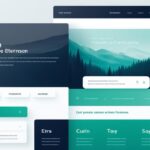Table of Contents
Loading animations are a crucial element in website design, ensuring a smooth user experience and high levels of engagement. When users visit a website, they expect quick response times. Even a slight delay can be perceived as a bug, leading to frustration and potential abandonment of the site. To combat this, designers have been using loading animations since the early days of the internet to provide feedback to users and minimize the perception of waiting time.
There are various types of loading animations, including progress bars, loading indicators, preloaders, and spinners. These animations have evolved over time alongside technological advancements. However, the key to effective loading animations lies in their design and implementation. Loading animations should be designed to be shown as little as possible, provide time estimation, explain the waiting process, reduce frustration, and align with the branding and company voice.
In this article, we will explore the best practices for creating loading animations that enhance user experience and maintain website engagement. We will discuss the importance of loading animations in website design and provide tips for creating effective loading animations. Additionally, we will showcase inspiring examples of loading animations and delve into the process of creating custom loading animations using tools like Sketch and Principle.
By following these best practices and utilizing the right tools, designers can create loading animations that seamlessly integrate into their websites, ensuring a positive user experience and increased user engagement.
The Importance of Loading Animations in Website Design
Loading animations play a critical role in website design, significantly impacting user engagement and reducing bounce rates. When a website takes too long to load, even for a brief period, users can quickly become frustrated and may choose to leave the site. To prevent this, loading animations provide valuable visual cues to users that the website is actively working to process their request. These animations instill confidence and reassure users that their actions are being processed.
Aside from their functional benefits, loading animations also contribute to setting the tone for the brand and creating a positive impression on users. By selecting loading animations that align with the brand identity and industry relevance, designers can establish a seamless and enjoyable user experience. A carefully chosen loading animation can convey professionalism, creativity, and attention to detail, enhancing the overall perception of the website and the brand it represents.
Incorporating loading animations into website design not only enhances user engagement but also helps in reducing bounce rates. When users encounter a well-executed loading animation, they are more likely to stay on the site and wait patiently for the content to load. This can significantly reduce the bounce rate, as users are engaged and willing to invest their time in exploring the website further.
Website design is a holistic process, and loading animations serve as an integral part of the user experience. By employing loading animations strategically, designers can guide users through the loading process, ensuring a smooth and fluid journey from landing page to fully loaded content.
“Loading animations provide valuable visual cues to users that the website is actively working to process their request.”
Benefits of Loading Animations in Website Design:
- Enhances user engagement.
- Reduces bounce rates.
- Instills confidence and reduces frustration.
- Sets the tone for the brand and creates a positive impression.
- Guides users through the loading process.
When implemented effectively, loading animations can transform the user experience, leaving a lasting impact on website visitors. By prioritizing loading animations during the design process, designers can create engaging and user-friendly websites that keep visitors coming back for more.
| Loading Animation Type | Use Cases | Benefits |
|---|---|---|
| Progress Bars | Longer loading processes | Clearly indicates loading progress |
| Loading Spinners | Shorter loading processes | Provides visual motion and feedback |
| Skeleton Screens | Highly anticipated content | Prevents screen flickering and maintains context |
Tips for Creating Effective Loading Animations
When it comes to creating loading animations, designers need to take into consideration several key factors to ensure their effectiveness. By following these tips and implementing best practices, designers can create loading animations that enhance user experience, align with brand identity, and captivate site visitors.
1. Choose the Right Animation Software
For delivering lightweight and professional-looking loading animations that seamlessly integrate into websites, designers should opt for animation software such as Lottie and Adobe After Effects. These tools offer powerful features and simplicity, making them ideal choices for designers looking to create visually appealing animations that load quickly.
2. Select a Design that Reflects Brand Identity
When choosing a loading animation design, it’s crucial to consider brand identity and industry relevance. Whether it’s counters, spinners, progress bars, geometric animations, animated logos, words, or illustrations, aligning the loading animation design with the brand’s identity adds a touch of uniqueness and consistency to the overall user experience.
3. Determine Animation Duration Based on Loading Time
The duration of a loading animation should be determined based on the site’s loading time. Finding the right balance between entertainment and functionality is essential to engage users while providing them with necessary feedback during the loading process. A loading animation that is too short may not effectively communicate progress, while one that is too long may lead to user frustration and abandonment.
4. Follow Best Practices
To create effective loading animations, designers should follow best practices to ensure an optimal user experience and brand impact. Some best practices include:
- Keeping the animations lightweight to minimize loading times and reduce strain on website performance.
- Incorporating branding elements, such as colors, logos, and typography, to reinforce brand identity and maintain consistency.
- Perfecting the concluding transition of the loading animation to provide a smooth transition from the loading state to the fully loaded state.
- Sticking to a clear message and avoiding clutter to ensure simplicity and user comprehension.
- Avoiding overcomplicating the animations, as simplicity often translates to better overall user experience.
By following these tips and best practices, designers can create loading animations that not only provide a seamless waiting experience but also enhance a website’s overall design, user experience, and brand identity.
Inspiring Examples of Loading Animations
Looking for inspiration for your loading animations? Look no further. We have curated a collection of impressive loading animation examples that showcase different design approaches and styles, catering to a wide range of industries and website types.
-
Slack Loading Animation:
This loading animation features rotating rounded squares that create a stretching effect. It not only captivates the user’s attention but also provides a visual representation of the loading process.
-
Trello Loading Animation:
Trello’s loading animation uses expanding rectangles to indicate progress. This dynamic animation effectively communicates that the website is working on the user’s request.
-
Flickr Loading Animation:
Flickr’s loading animation showcases alternating colored circles that create an engaging visual effect. This animation not only keeps users entertained but also provides feedback on the loading process.
Additionally, we have identified several other websites with impressive loading animations:
- Eonix
- Matteo Fabbiani
- Chicago CryoSpa
- Jay Bell
- JORIS
- The Circle & The Square
- Glow Flow Yoga by Nina Park
- Sundown Studio
These websites demonstrate the versatility and creativity that can be achieved with loading animations. Take inspiration from their designs and adapt them to suit your own website and brand.
Remember, loading animations are not only functional but also contribute to the overall user experience and engagement. Choose loading animations that align with your website design and create a positive impact on your users.
Now that you’ve seen some inspiring examples, it’s time to unleash your creativity and design loading animations that will captivate your users and enhance their website experience.
Creating Custom Loading Animations
Designers can leverage tools like Sketch and Principle to effortlessly create bespoke loading animations that seamlessly integrate with their app’s design. Sketch empowers designers to craft fundamental shapes and designs, which can then be imported into Principle for animation development. With Sketch’s extensive range of features and options for creating shapes, colours, and gradients, designers can transform their creative ideas into reality. Moreover, Principle equips designers with tools to produce animations, apply triggers, and link artboards, streamlining the process of creating unique loading animations. By harnessing the combined capabilities of Sketch and Principle, designers can fashion visually captivating, professional-looking loading animations that harmoniously align with their app’s overall design.
Advantages of Sketch:
- Robust set of features for creating shapes, colours, and gradients
- Effortless integration with Principle for animation creation
- Creation of basic shapes and designs for loading animations
Benefits of Principle:
- Seamless animation development
- Application of triggers for enhanced interactivity
- Smooth artboard linking for cohesive loading animations
Conclusion
Loading animations are an essential aspect of website design as they significantly contribute to enhancing user experience and maintaining user engagement. When creating loading animations, designers must carefully consider the specific needs and requirements of their brand and industry. By following best practices, such as keeping the animations lightweight, incorporating branding elements, and providing a clear message, designers can create loading animations that effectively communicate with users and leave a positive impression.
Tools like Sketch and Principle provide designers with the freedom to create custom loading animations that are unique, visually appealing, and aligned with their app’s design. These tools offer a wide range of features and options to bring creative ideas to life.
By implementing loading animation best practices, designers can enhance the overall user experience and maintain user engagement on their websites. Well-executed loading animations not only reduce frustration by providing visual cues that the website is working, but they also set the tone for the brand and create a seamless and enjoyable user journey. With careful consideration and attention to detail, loading animations can play a crucial role in enhancing website engagement and creating a positive user experience.
FAQ
Why are loading animations important in website design?
Loading animations are important in website design as they enhance user experience, maintain engagement, and reduce bounce rates. They provide visual cues that the website is working and processing users’ requests, instilling confidence and reducing frustration.
What types of loading animations are commonly used?
Common types of loading animations include progress bars, loading indicators, preloaders, and spinners.
How long should a loading animation be?
The duration of a loading animation should be based on the website’s loading time. It is important to strike a balance between entertainment and functionality in loading animations.
What factors should designers consider when creating loading animations?
Designers should consider factors such as choosing animation software, selecting a design that reflects the brand identity, determining the loading animation duration, and following best practices.
Can you provide some examples of inspiring loading animations?
Yes, some examples include the Slack loading animation using rotating rounded squares, the Trello loading animation with expanding rectangles, and the Flickr loading animation featuring alternating colored circles.
What tools can designers use to create custom loading animations?
Designers can use tools like Sketch and Principle to create custom loading animations that match the design of their apps.













